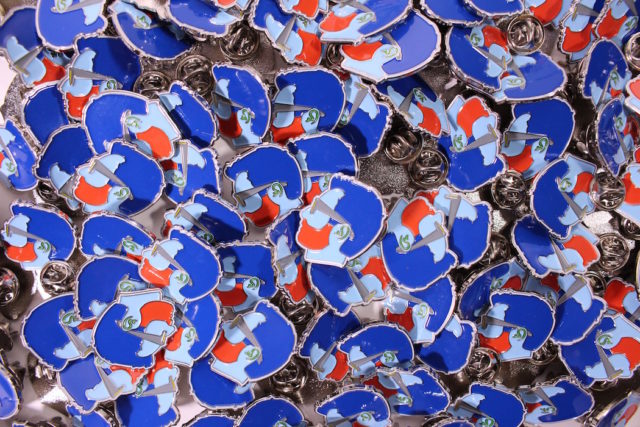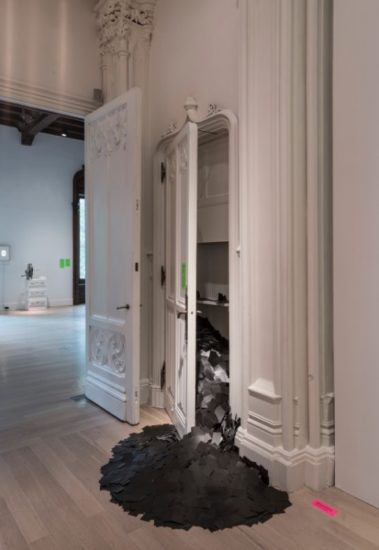
Installation view of the Take Me (I’m Yours). September 16, 2016 – February 5, 2017. The Jewish Museum, NY (Photo by: David Heald; Courtesy The Jewish Museum)
Take Me (I’m Yours)
The Jewish Museum
1109 5th Avenue
New York, NY
On view until February 5, 2017
A loud, tacky sign emblazoned with “Everything Must Go” would not feel out of place in the Jewish Museum’s current exhibition Take Me (I’m Yours). A rack of plastic goodie bags branded with the exhibition’s title hang in the show’s entrance, encouraging viewers to fill up on artist-made pins, T-shirts, used clothing, candy and a 25-cent ball of air from Yoko Ono. With this free-for-all curatorial style, the exhibit looks more like a display of samples than a contemporary art show.
That’s a bad thing. The whole show feels like a gimmick designed to lure people in the door by offering them free swag. Meanwhile, the Museum is presenting the idea that they are challenging the traditional relationship between art and its viewers, which not only isn’t true (it’s been done to death), it distracts from the sociopolitical critiques made by many of the artists in the show. Simply put, the show is a disaster.
The exhibition revisits the same named 1995 show curated by Hans Ulrich Obrist and artist Christian Boltanski at London’s Serpentine Galleries. Obrist joins the Jewish Museum’s Jens Hoffmann and Kelly Taxter for the reboot, significantly expanding the original show’s roster from twelve to forty-two. This excess of artists, jam-packed into the Museum’s second floor galleries, is, at least, partially responsible for its flea market aesthetic.

Alex Israel, Self-Portrait (Lapel Pin), 2016. Installation view of the exhibition Take Me (I’m Yours) at The Jewish Museum, NY (Photo by: David Heald; Courtesy the artist and The Jewish Museum)
Entering the galleries, viewers maneuver between numerous cheap plastic containers that are used as de facto pedestals and storage bins. These white boxes are filled to the brim with tchotchkes like Alex Israel’s self-portrait lapel pins, Rachel Rose and Ian Cheng’s ironic fortune cookies (mine said: “This is more and less Jewish than you think”), Andrea Fraser’s dry business contracts and Gilbert & George’s nihilistic buttons emblazoned with phrases like “Fuck the planet” and “Fellatio for all.” Maybe with more curatorial restraint, these works would be compelling, but here, they just looked like bargain bins trinkets.
When not confined to oversized Tupperware, the rest of the art mostly sits in piles on the floor. A row of lemon seltzer water by Adriana Martinez is stacked like a brick wall near a set of windows while red placebo pills tumble out of a dispenser by Carsten Höller. In another room, Christian Boltanski’s mountain of used clothing invites viewers to pick out their new wardrobe.

Felix Gonzalez-Torres, Untitled (USA Today), 1990, candies individually wrapped in red, silver and blue cellophane, endless supply (photo by author)
Between the haphazard and distracting exhibition design and the frequent encouragement by the museum’s staff to take the art, the works with political messages were all but lost. Take, for example, Felix Gonzalez-Torres’s Untitled (USA Today), one of Gonzalez-Torres’s iconic candy installations that lies in a long stripe across one gallery. Like his more well-known Untitled (Portrait of Ross in L.A.), which matches the weight of the candy to the weight of his partner living with AIDS, Untitled (USA Today) presents a conceptual response to the enormous losses endured during the height of the HIV/AIDS crisis.
Untitled (USA Today) was created in 1990 when, according to amfAR, 120,453 people in the United States had died of AIDS-related causes by the end of that year. Using red, white and blue-wrapped hard candy, each individual piece chosen by viewers represents the gradual disappearance of Americans living with AIDS. It’s an elegiac and deeply tragic memorial to the people behind these anonymous statistics.
While taking a piece of this candy is supposed to be an act of remembrance of those who died from complications from AIDS, the work, in the context of Take Me (I’m Yours), might as well be a suggested pairing with Martinez’s seltzer water. With viewers tossing it in a bag with the rest of the swag as a snack, it felt garish and counter to the piece’s somber intent. The curators’ feeble attempt at resolving the content issues—small neon-colored explanatory wall labels—isn’t going to fix a problem that stretches across an entire floor of exhibition space.

Heman Chong, Monument to the People We’ve Conveniently Forgotten (I Hate You), 2008. Installation view of the exhibition Take Me (I’m Yours) at The Jewish Museum, NY (Photo by: David Heald; Courtesy the artist and The Jewish Museum)
Perhaps because of the curators’ overpowering emphasis on free stuff, the most successful works in the show were the least enticing to viewers looking for swag. Nowhere was this more apparent than in Heman Chong’s Monument To The People We’ve Conveniently Forgotten (I Hate You). Squirreled away in a closet adjacent to the main exhibition space, a mound of small rectangular black cards tumbles out from the open door. The mysteriously blank black and white cards are made to the size of typical ID cards. With one side blacked out and the other white, the cards, at once, look redacted or erased.
Much like Gonzalez-Torres’ Untitled (USA Today), Chong’s installation represents the invisible. Only here, he’s depicting the countless invisible, undocumented immigrants or refugees who are often ignored and overlooked. Particularly when viewed in the context of the forthcoming Trump administration’s dangerous xenophobic and anti-immigrant rhetoric (though the piece doesn’t solely focus its critique on the United States), the installation symbolizes the numerous nameless individuals whose lives are now increasingly threatened. It’s a disarmingly simple concept for an installation, but it’s arresting in its timeliness.
And yet, I was the only person interested in Chong’s installation at the time of my visit. I got a couple curious glances from other viewers when I was looking at the cards rather than munching my way through the nearby fortune cookies. Admittedly, blank ID cards are less collectible than foodstuffs. But, to me, engaging with a work of art that articulates a social critique at a crucial time is worth more than a bag full of knick-knacks.


Comments on this entry are closed.